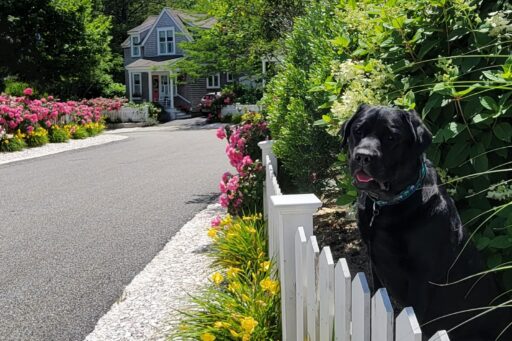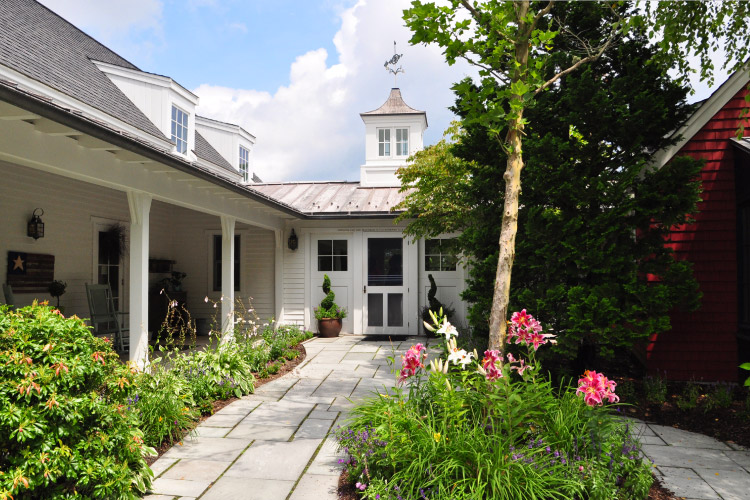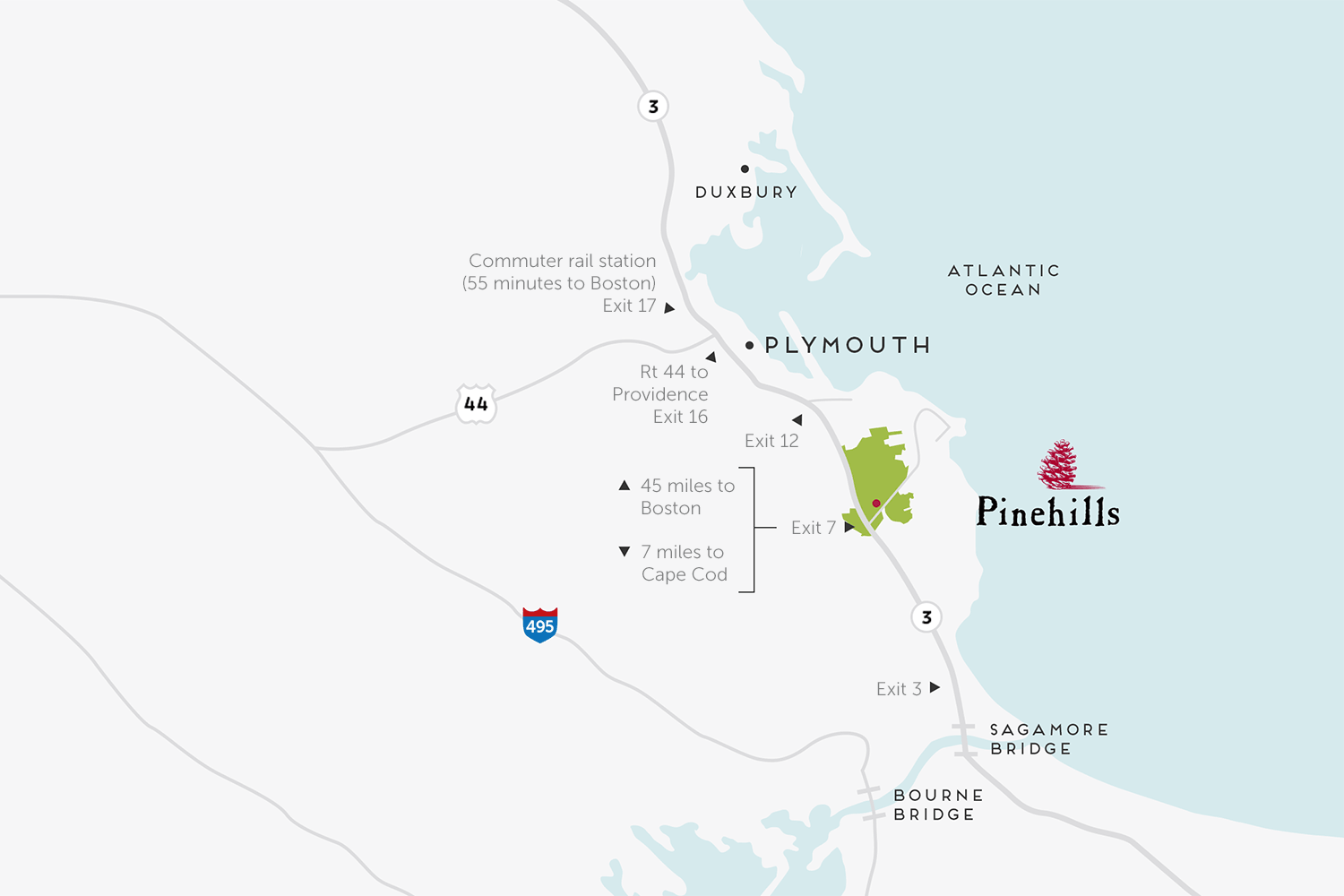Pinehills means big bucks for Plymouth, and its own take on ‘smart growth’
Pat Martin boasts she has brought her husband, Pepper, back to his roots. Pepper Martin was born in Plymouth 83 years ago, a 10th-generation descendant of Governor William Bradford, but once he left for college, he returned to visit but never to stay.
That changed in 2001, when the Martins, looking for a place to retire, laid eyes on what would ultimately become their home in The Pinehills.
“All that was here was the road and the golf course,’’ Pat Martin said recently. After checking out the view from stands positioned for prospective homeowners, the Martins were hooked.
From their cozy living room today, the couple watch golfers tee off on the first hole of one of three resort-quality courses. The Martins have the distinction of being the first to settle in what is now the largest and most widely praised master planned development in New England. Their Forest Edge neighborhood plans to toast its 10th anniversary today.
A decade after the first shovel dipped into this hilly, 3,174-acre slice of Plymouth, about 1,500 homes have been built. Permits allow for a little under 1,500 more. The mix includes age-restricted neighborhoods, apartments, townhouse condominiums, and single-family homes.
A lively commercial center, known as the Village Green, boasts a dry cleaners, grocer, liquor store, spa, hair salon, and specialty shops, as well as a post office. Professional services abound. And construction on a full-service gas station is underway, with plans to open early next year.
There are plenty of recreational opportunities. The development offers 7 miles of walking trails, a private golf club in addition to the two public courses, a swimming pool, tennis courts, and a community building with ample space for classes, conferences, or relaxation by the fireplace.
“The only thing I have to go out for is church,’’ said Carole Jenkins, who moved to Pinehills seven years ago.
The vision for The Pinehills dates to 1996, when Boston developer Tony Green checked out the property, its 5-square-mile area bigger than Belmont. Its poor soil, the result of a receding glacier millions of years ago, had limited its use to hunting.
The only buildings there, according to Plymouth historian James Baker, were an 18th-century tavern and remnants of a hunting lodge that had belonged to a New Jersey textile baron. The land was owned at the time by Digital Corp., which had abandoned plans for an office complex.
“It was heavily treed and possessed unusual beauty,’’ recalled Green, now a managing partner of The Pinehills. “And it was clear there was an enormous amount of privacy here’’ and boundless opportunity for spectacular views.
However, The Pinehills that planners envisioned could not be built under Plymouth’s zoning bylaws. Two years of discussion followed, and local officials ultimately threw out the rule book and established an “Open Space Mixed Use Development’’ permit, affording The Pinehills principals the flexibility to construct a “smart development’’ the state now uses as a model.
“Pinehills serves as an excellent example of compact design, reduction of impervious surfaces, water conservation, waste-water re-use, and historic preservation,’’ according to the online “toolkit’’ for smart growth and smart energy development posted by the state Executive Office of Energy and Environmental Affairs.
Although the number of homes is large, clustered lots as small as 6,000 square feet create an impression of cozy neighborhoods surrounded by green space. Housing is limited to 900 acres. The remaining 2,200-plus are open, for either active or passive recreation.
“The amount of open space there is unique,’’ said Lee Hartmann, Plymouth’s planning and development director. “It’s also the amenities. It’s not just houses. There’s the Stonebridge [community center], golf, events, and it even has its own green like Plymouth’s other villages.’’
Pinehills president John Judge said “market research of a different sort’’ was conducted before building. “We held 300 workshops with prospective customers, where we handed out magazines, scissors, and glue sticks and asked them to create their vision of home.’’ The collages identified view as a top priority. “Site planning was done by view rather than frontage,’’ Judge said.
Thanks to the open space mixed-use permit, developers carved narrow country roads following the natural contour of the land, often making small detours to accommodate a large rock or stand of trees. Homes are also tucked into the terrain. “We’re trying to fit into our natural environment,’’ Green said.
The recently sluggish housing market has not seriously affected The Pinehills. Adjustments were made, Green said. Houses became smaller and simpler. And lately, a nostalgic cottage design has gained tremendous popularity.
Hartmann praised the developers’ ability to adapt. “They’re still building more than 100 homes a year,’’ Hartmann said. “That’s more than half all the houses built in town.’’
Plymouth officials were initially concerned over the potential impact on town services, so The Pinehills installed its own water and waste-water systems, and does all plowing and road maintenance.
The impact on schools was also a concern, but as predicted, few children live in the development. The school bus currently picks up only 42 students each day.
John Stilgoe, a professor of environmental studies at Harvard University, said The Pinehills possesses considerable beauty, and its well-planned commercial center provides residents with convenience. The development also serves as a technological model, he said, based on its underground utility system.
But Stilgoe questioned its smart-growth value. “The Pinehills is smart growth with no kids, which is an oxymoron,’’ he said. “The big issue with looking at The Pinehills as a prototype is the absence, or small numbers, of children. It could have included not only a commercial center, but it could have built a little school, maybe K-6.’’
Pinehills developers expect the number of children to always remain small, which will keep it from becoming a tax burden to Plymouth. “The average age here is young 50s, generally speaking, without kids,’’ Green said.
The location also defies the smart-growth standard of proximity to public transportation, Stilgoe said. “If the Old Colony railroad had a station there, it would be a national model for smart growth,’’ he said. “But exit 3 is a long way down. The people living in The Pinehills have a very long drive to the city and a reasonably long drive to the Kingston train station. On the face of it, it’s smart growth, but to live there and work there is going to take a lot of gas.’’
Hartmann said The Pinehills adds a lifestyle option for area residents, but it may not be for everyone. “Plymouth has a range of lifestyles to choose from, like downtown, rural areas, and traditional subdivisions,’’ Hartmann said. “Pinehills is just one more choice.’’
Rich and Rose Havens, in their 50s with no children, fit the typical Pinehills profile. Rich is semiretired while Rose works in Boston and from home. Living in the Great Kame district of The Pinehills actually trimmed her commute, since the couple used to live in Sandwich.
The Havenses enjoy the social side of Pinehills living. “In Sandwich, we had one block party in four years,’’ Rich Havens said. “Here, we’ve had about 30.’’
Meanwhile, Ryan and Pooja Deveau, thirty-somethings who work as consultants for a Boston medical device company, didn’t think children were allowed when they first checked out The Pinehills. “We found out that was false,’’ said Ryan Deveau.
The couple has a house on Wickertree Lane, a 3-year-old son, and a gym set in the backyard. Five other children live on their street.
“This is a great place for kids to be,’’ said Pooja Deveau, who volunteers with the Pine Cone Club, an activity group for local children. Last spring’s Easter party drew 50 children and grandchildren of Pinehills residents - only a handful in a development of some 3,000 residents.
The relative absence of children maintains The Pinehills’ financial benefit to Plymouth. Judge said local officials recently commissioned a study to scrutinize the net tax benefit of the development, considering everything from school-age children to ambulance use.
“The bottom line was 90 cents on every dollar goes to benefit Plymouth,’’ Judge said. “Their conclusion was this was the most net-positive project they had seen.’’
According to the town assessor’s office, The Pinehills is Plymouth’s second-largest taxpayer, at $9.5 million annually, just behind Entergy, owner of the Pilgrim nuclear power plant, at $9.7 million.
Judge predicts The Pinehills will soon be the top taxpayer: “We’ll probably pass Entergy this year.’’





